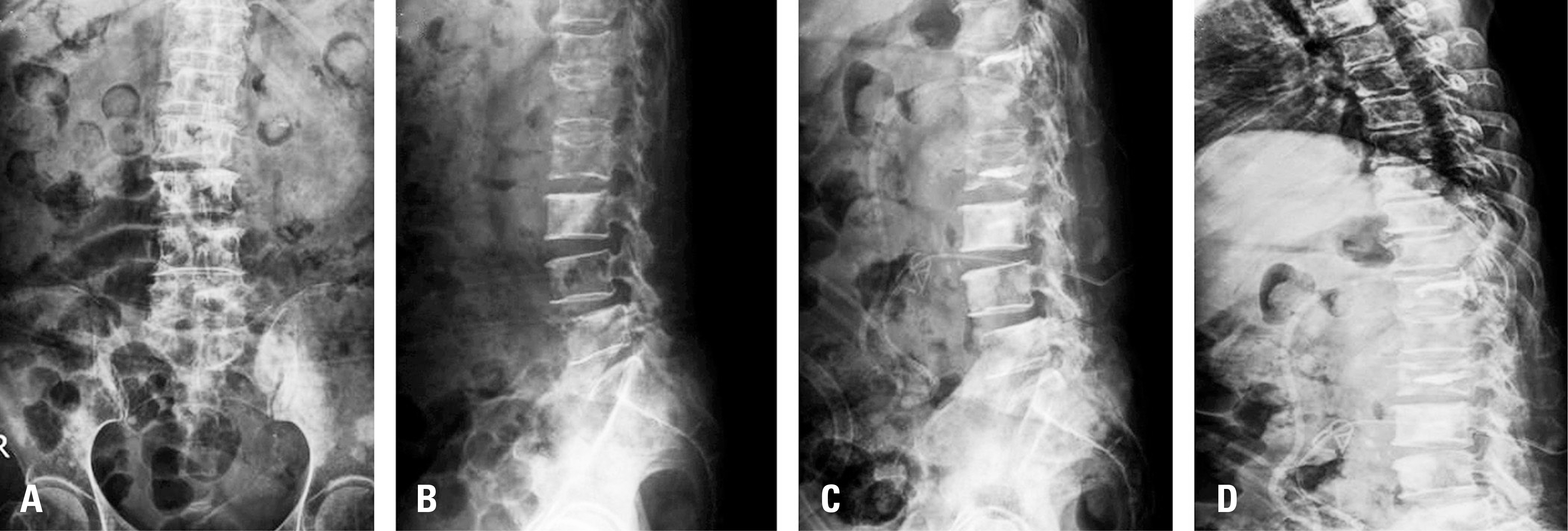J Korean Soc Spine Surg.
2016 Dec;23(4):207-215. 10.4184/jkss.2016.23.4.207.
Clinical Efficacy and Safety of Radiofrequency Ablation Therapy with Cement Augmentation for a Metastatic Spine Tumor
- Affiliations
-
- 1Department of Orthopedic Surgery, Kosin University Gospel Hospital, Busan, Korea. mewha98@naver.com
- KMID: 2365080
- DOI: http://doi.org/10.4184/jkss.2016.23.4.207
Abstract
- STUDY DESIGN: Retrospective study.
OBJECTIVES
To evaluate the clinical efficacy and safety of radiofrequency (RF) ablation therapy followed by a bone cement augmentation procedure in treating and managing pain among metastatic spine tumor patients. SUMMARY OF LITERATURE REVIEW: As a metastatic spine tumor is unresectable, this procedure was performed. Results showed an increase in the necrosis rate, and a decrease in local recurrence and secondary vertebral stability.
MATERIALS AND METHODS
From March 2007 to April 2016, 26 patients who were treated with RF ablation with a bone cement augmentation procedure and the same number of patients treated with radiotherapy for metastatic spine lesions were included in this study. Pain relief and functional quality of life were evaluated using a visual analogue scale (VAS) and Roland Morris Questionnaire (RMQ).
RESULTS
VAS scores preoperatively and at 1, 4, and 12 weeks follow-up were 7.45, 3.01, 3.78, and 2.97 in the procedure group, and 7.04, 6.65, 5.87, and 3.03 in the radiotherapy group. The procedure group had significantly better average outcomes than the radiotherapy group for pain relief at 4 weeks but showed no difference at 12 weeks. The RMQ score improved from 13.92 to 7.21 in the procedure group, and from 15.33 to 9.75 in the radiotherapy group. Two patients who had a metastatic tumor near the vertebral body posterior cortex showed cement leakage into the disc space, that is, intraforaminal and intracanal space; therefore, operations were performed (7.69% nerve injury).
CONCLUSIONS
RF ablation therapy with cement augmentation in treatment of metastatic spine tumor shows effectiveness in early pain relief and brings immediate vertebral stability, helping patients return to normal life. However, it carries a risk of nerve injury due to cement leakage.
Keyword
MeSH Terms
Figure
Reference
-
1. Wise JJ, Fischgrund JS, Herkowitz HN, et al. Complication, survival rates, and risk factors of surgery for metastatic disease of the spine. Spine(Phila Pa 1976). 1999; 24:1943–51.
Article2. Jang JH, Kim JD. Radiofrequency ablation therapy with vertebroplasty or kyphoplasty in metastatic spine tumor. J Korean Bone Joint Tumor Soc. 2007; 13:1–6.3. Jang JH, Park YK. The comparison of the radiofrequency ablation therapy with vertebroplasty and radiotherapy in metastatic spine tumor. J Korean Orthop Assoc. 2011; 46:122–9.4. Wright RL. Malignant tumors in the spinal extra-dural space: results of surgical treatment. Ann Surg. 1963; 157:227–31.5. Chung CY, Lee SY, Baek GH, et al. Clinical analysis of metastatic bone tumor. J Korean Orthop Assoc. 1991; 26:1855–9.
Article6. Tong D, Gillick L, Hendrickson FR. The palliation of symptomatic osseous metastases: final results of the study by the radiation therapy oncology group. Cancer. 1982; 50:893–9.
Article7. Janjan NA. Radiation for bone metastases: conventional techniques and the role of systemic radiopharmaceuticals. Cancer. 1997; 80:1628–45.8. Tomita K, Kawahara N, Kobayashi T, et al. Surgical strategy for spinal metastases. Spine(Phila Pa 1976). 2001; 26:298–306.
Article9. Grö nemeyer DH, Schirp S, Gevargez A, et al. Image-guided radiofrequency ablation of spinal tumors: preliminary experience with an expandable array electrode. Cancer J. 2002; 8:33–9.10. Nakatsuka A, Yamakado K, Maeda M, et al. Radiofre-quency ablation combined with bone cement injection for the treatment of bone malignancies. J Vasc Interv Radiol. 2004; 15:707–12.
Article11. Padina S, Sean D, Kieran M, et al. Comparison of the effect of two different bone-targeted radiofrequency ablation (RFA) systems alone and in combination with percutaneous vertebroplasty (PVP) on the biomechanical stability of the metastatic spine. Eur Spine J. 2015 Jul 24.
Article12. Huang M, Zhu H, Liu T, et al. Comparison of external radiotherapy and percutaneous vertebroplasty for spinal metastasis. Asia-Pacific Journal of Clinical Oncology. Asia Pac J Clin Oncol. 2016; 12:E201–8.13. Erdem E, Akdol S, Amole A, et al. Radiofrequency-tar-geted vertebral augmentation for the treatment of vertebral compression fractures as a Result of Multiple Myeloma. Spine(Phila Pa 1976). 2013; 38:1275–81.
Article14. Pezeshki PS, Davidson SR, Akens MK, et al. Helical coil electrode radiofrequency ablation designed for application in osteolytic vertebral tumors-initial evaluation in a porcine model. Spine J. 2015; 15:1832–40.
Article15. Padina S, Jason Woo, Margarete K, et al. Evaluation of a bipolar-cooled radiofrequency device for ablation of bone metastasis: preclinical assessment in porcine vertebrae. Spine J. 2014; 14:70.
- Full Text Links
- Actions
-
Cited
- CITED
-
- Close
- Share
- Similar articles
-
- The Comparision of the Radiofrequency Ablasion Therapy with Vertebroplasty and Radiotherapy in Metastatic Spine Tumor
- Comparing palliative treatment options for cholangiocarcinoma: photodynamic therapy vs. radiofrequency ablation
- Interventional treatments for cancer pain due to bone metastasis
- Therapy of Pancreatic Neuroendocrine Tumors: Fine Needle Intervention including Ethanol and Radiofrequency Ablation
- Treatment of Metastatic Carcinoma Involvign Cervical Spine by Using Bone Cement




